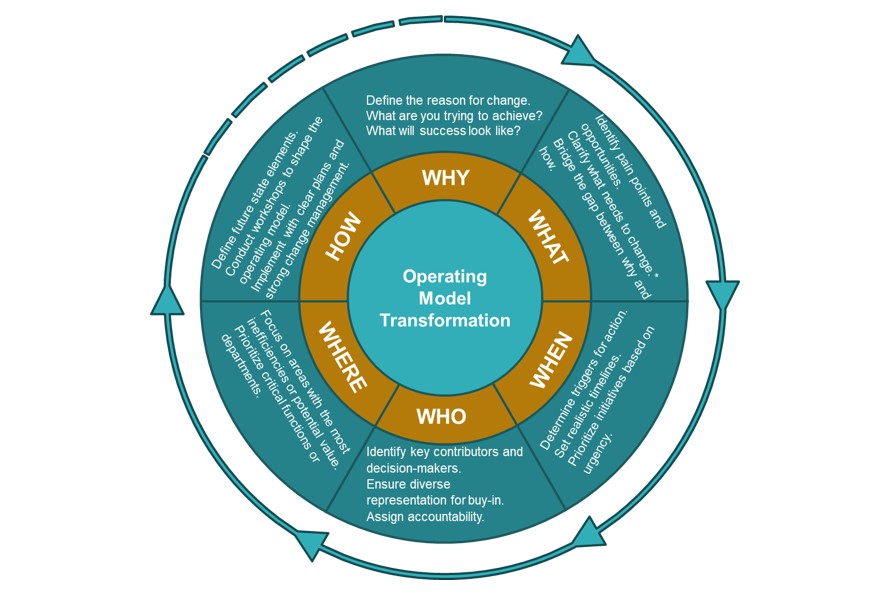Rudyard Kipling’s six honest serving men — What, Why, When, How, Where, and Who — laid the foundation for the 5W1H method, a powerful framework for problem-solving and decision-making. When applied to organizational transformation, particularly in redesigning an operating model, this method provides clarity and structure to a complex process. Let’s explore how the 5W1H approach can guide you through the journey of operating model change.
“I keep six honest serving-men (They taught me all I knew); Their names are What and Why and When
And How and Where and Who. I send them over land and sea, I send them east and west; But after they have worked for me, I give them all a rest.”
–Rudyard Kipling
Why Change Your Operating Model?
The first step in any transformation is understanding why change is necessary. Ask yourself:
-
- Are you struggling to fulfill your strategic goals?
- Are employees disengaged or leaving for better opportunities?
- Are market disruptions or inefficiencies threatening your growth?
Your “why” defines the purpose behind the change and sets the stage for aligning your team around a shared vision. For example, if your current model hinders innovation or agility, addressing these challenges becomes your driving force.
What Needs to Change?
Once you’ve established why change is needed, focus on what specifically must evolve. This step bridges the gap between purpose and action:
-
- What are the pain points in your current operations?
- What outcomes do you envision after implementing changes?
This clarity is often missing because it requires deep analysis and documentation of both existing inefficiencies and desired future states. Conducting a thorough assessment of current processes, systems, and stakeholder feedback is essential.
When Should You Act?
Timing is critical in any transformation. The when involves:
-
- Identifying triggers for change (e.g., declining performance metrics or market shifts).
- Setting realistic timelines for planning and implementation.
- Prioritizing initiatives based on urgency and impact.
For example, if competitive pressures are intensifying, waiting too long to act could jeopardize your position in the market.
Who Needs to Be Involved?
An effective operating model redesign requires collaboration across all levels of the organization:
-
- Who are the key stakeholders that need to contribute?
- Who will lead the transformation efforts?
- Who will be affected by these changes?
Involving diverse perspectives ensures buy-in and helps create a robust model that addresses various needs. Establishing dedicated working groups and steering committees can expedite decision-making and foster alignment.
Where Will Changes Have the Most Impact?
The where focuses on identifying areas within your organization that will benefit most from transformation:
-
- Where are inefficiencies most pronounced?
- Where can improvements drive the greatest value?
For instance, if customer service is a weak link in your operations, prioritizing changes in this area could yield significant benefits.
How Will You Implement Change?
The final piece of the puzzle is determining how to bring your vision to life:
-
- How will you design your future state operating model?
- How will you ensure successful implementation?
This involves defining design principles that align with strategic priorities, conducting workshops to shape the future state, and documenting decisions clearly. Implementation should include actionable initiatives, accountability structures, and robust change management efforts to ensure employees understand and embrace the new model.
Steps to Redesign Your Operating Model Using 5W1H
Here’s a structured approach using 5W1H:
1. Start with Why
Define what you’re trying to achieve and why it matters. Visualize how success will look post-change.
2. Assess Your Current State
Identify what’s working and what isn’t by gathering input from stakeholders and reviewing existing documentation.
3. Determine If Change Is Necessary
Evaluate what improvement or significant transformation is needed. Build a compelling case for change if required.
4. Engage the Right People
Ensure representation from across business units to foster collaboration and diversity of thought.
5. Define Design Principles
Establish guidelines for how your organization should operate to meet strategic goals effectively.
6. Shape Your Future State
Use workshops to define critical elements of your operating model while addressing contentious issues head-on.
7. Visualize
Create a coherent visualization of your future state that resonates with stakeholders and serves as a roadmap for implementation.
8. Implement with Precision
Develop actionable plans, assign accountability, and maintain momentum through strong communication and change management.
Combining Kipling’s timeless questions with modern problem-solving techniques offers a structured yet flexible framework for transforming your operating model. By systematically addressing why, what, when, who, where, and how, organizations can navigate complexity with clarity and purpose. Remember: success lies not just in planning but in execution—bringing your new operating model to life through collaboration, commitment, and continuous improvement.
Questions;
What are the pain points in your current operations?
How could 5W1H method, improve your problem-solving and decision-making?
Join the conversation at our LinkedIn group!
The LPPDE Conference May 5-8, 2025 in Stockholm will be exploring these ideas as well as many more and provide a forum for participants to share, learn, and collaborate with other like-minded development leaders.

Bengt Johansson
Funder & Owner of Lean Peak Solutions
Bengt Johansson is a seasoned professional with extensive experience in Product Development, Quality Management, and Project Leadership. Over his career at ASSA ABLOY AB, he has trained and coached over 1,800 individuals in Lean-Agile practices and implemented effective tools like Obeya-rooms and Lean Project Portfolio Management. Bengt has a proven track record of optimizing workflows, aligning strategic processes, and fostering continuous improvement across global operations.



